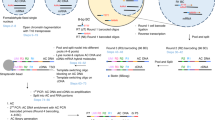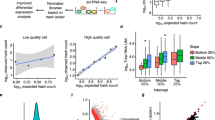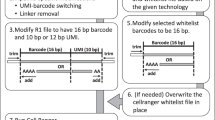Abstract
Single-cell combinatorial indexing RNA sequencing (sci-RNA-seq) is a powerful method for recovering gene expression data from an exponentially scalable number of individual cells or nuclei. However, sci-RNA-seq is a complex protocol that has historically exhibited variable performance on different tissues, as well as lower sensitivity than alternative methods. Here, we report a simplified, optimized version of the sci-RNA-seq protocol with three rounds of split-pool indexing that is faster, more robust and more sensitive and has a higher yield than the original protocol, with reagent costs on the order of 1 cent per cell or less. The total hands-on time from nuclei isolation to final library preparation takes 2–3 d, depending on the number of samples sharing the experiment. The improvements also allow RNA profiling from tissues rich in RNases like older mouse embryos or adult tissues that were problematic for the original method. We showcase the optimized protocol via whole-organism analysis of an E16.5 mouse embryo, profiling ~380,000 nuclei in a single experiment. Finally, we introduce a ‘Tiny-Sci’ protocol for experiments in which input material is very limited.
This is a preview of subscription content, access via your institution
Access options
Access Nature and 54 other Nature Portfolio journals
Get Nature+, our best-value online-access subscription
$29.99 / 30 days
cancel any time
Subscribe to this journal
Receive 12 print issues and online access
$259.00 per year
only $21.58 per issue
Buy this article
- Purchase on Springer Link
- Instant access to full article PDF
Prices may be subject to local taxes which are calculated during checkout








Similar content being viewed by others
Data availability
Raw data from the E16.5 mouse embryo is available for download from the NCBI Gene Expression Omnibus repository with accession number GSE186824. Original photos and gels have been deposited at Figshare (https://doi.org/10.6084/m9.figshare.c.5915834).
References
Domcke, S. et al. A human cell atlas of fetal chromatin accessibility. Science 370, eaba7612 (2020).
Cusanovich, D. A. et al. Multiplex single cell profiling of chromatin accessibility by combinatorial cellular indexing. Science 348, 910–914 (2015).
Cao, J. et al. Comprehensive single-cell transcriptional profiling of a multicellular organism. Science 357, 661–667 (2017).
Cao, J. et al. The single-cell transcriptional landscape of mammalian organogenesis. Nature 566, 496–502 (2019).
Rosenberg, A. B. et al. Single-cell profiling of the developing mouse brain and spinal cord with split-pool barcoding. Science 360, 176–182 (2018).
Datlinger, P. et al. Ultra-high throughput single-cell RNA sequencing by combinatorial fluidic indexing. Nat. Methods 18, 635–642 (2021).
Lareau, C. A. et al. Droplet-based combinatorial indexing for massive-scale single-cell chromatin accessibility. Nat. Biotechnol. 37, 916–924 (2019).
Vitak, S. A. et al. Sequencing thousands of single-cell genomes with combinatorial indexing. Nat. Methods 14, 302–308 (2017).
Yin, Y. et al. High-throughput single-cell sequencing with linear amplification. Mol. Cell 76, 676–690.e10 (2019).
Ramani, V. et al. Massively multiplex single-cell Hi-C. Nat. Methods 14, 263–266 (2017).
Mulqueen, R. M. et al. Highly scalable generation of DNA methylation profiles in single cells. Nat. Biotechnol. 36, 428–431 (2018).
Cao, J. et al. Joint profiling of chromatin accessibility and gene expression in thousands of single cells. Science 361, 1380–1385 (2018).
Cao, J., Zhou, W., Steemers, F., Trapnell, C. & Shendure, J. Sci-fate characterizes the dynamics of gene expression in single cells. Nat. Biotechnol. 38, 980–988 (2020).
Hwang, B. et al. SCITO-seq: single-cell combinatorial indexed cytometry sequencing. Nat. Methods 18, 903–911 (2021).
Wang, Q. et al. CoBATCH for high-throughput single-cell epigenomic profiling. Mol. Cell 76, 206–216.e7 (2019).
Srivatsan, S. R. et al. Massively multiplex chemical transcriptomics at single-cell resolution. Science 367, 45–51 (2020).
Srivatsan, S. R. et al. Embryo-scale, single-cell spatial transcriptomics. Science 373, 111–117 (2021).
Cao, J. et al. A human cell atlas of fetal gene expression. Science 370, eaba7721 (2020).
Qiu, C. et al. Systematic reconstruction of cellular trajectories across mouse embryogenesis. Nat. Genet. 54, 328–341 (2022).
Ehrenberg, L., Fedorcsak, I. & Solymosy, F. Diethyl pyrocarbonate in nucleic acid research. Prog. Nucleic Acid Res. Mol. Biol. 16, 189–262 (1976).
Dobin, A. et al. STAR: ultrafast universal RNA-seq aligner. Bioinformatics 29, 15–21 (2013).
Acknowledgements
We thank Bridget Kulesakara for the sucrose buffer advice, Jase Gehring for fixative expertise and Riza Daza for helpful feedback. We thank Diana O’Day, Mai Le, Roshella Gomes, Saskia Ilcisin and Dana Jackson for protocol testing, and the entire Shendure Lab for support and encouragement. This work was funded in part by NIH R01HG010632 to J.S. and C.T., UM1HG011586 to J.S. and B.J.B., R35GM137916 to B.J.B. and T32HG000035 to E.N. J.S. is an Investigator of the Howard Hughes Medical Institute.
Author information
Authors and Affiliations
Contributions
B.K.M. developed the improved protocol with input and testing from E.N., M.P., R.G.-G., S.S., R.B.-G. and J.C. C.Q. performed all data analysis. E.N. collected and staged mouse embryos. J.C. developed the original protocol. B.J.B., C.T. and J.S. supervised aspects of the work, with J.S. providing overall oversight. B.K.M., C.Q. and J.S. wrote the paper, with input from all authors.
Corresponding authors
Ethics declarations
Competing interests
J.S. is a scientific advisory board member, consultant and/or cofounder of Cajal Neuroscience, Guardant Health, Maze Therapeutics, Camp4 Therapeutics, Phase Genomics, Adaptive Biotechnologies and Scale Biosciences. C.T. is a founder of Scale Biosciences. All other authors have no competing interests.
Peer review
Peer review information
Nature Protocols thanks Linas Mazutis, Samantha Morris and the other, anonymous, reviewer(s) for their contribution to the peer review of this work.2
Additional information
Publisher’s note Springer Nature remains neutral with regard to jurisdictional claims in published maps and institutional affiliations.
Related links
Key references using this protocol
Qiu, C. et al. Nat. Genet. 54, 328–341 (2022): https://doi.org/10.1038/s41588-022-01018-x
Cao, J. et al. Science 357, 661–667 (2017): https://doi.org/10.1126/science.aam8940
Cao, J. et al. Nature 566, 496–502 (2019): https://doi.org/10.1038/s41586-019-0969-x
Supplementary information
Supplementary Information
Supplementary Figs. 1–4 and Supplementary Results
Supplementary Table 1
Indexed primer sets
Supplementary Video 1
Demonstration of nuclei isolation
Source data
Source Data Fig. 3
Unprocessed photo
Source Data Fig. 4
Unprocessed photo
Source Data Fig. 5
Unprocessed photo
Source Data Fig. 6
Unprocessed photo
Source Data Fig. 7
Unprocessed photo
Rights and permissions
Springer Nature or its licensor holds exclusive rights to this article under a publishing agreement with the author(s) or other rightsholder(s); author self-archiving of the accepted manuscript version of this article is solely governed by the terms of such publishing agreement and applicable law.
About this article
Cite this article
Martin, B.K., Qiu, C., Nichols, E. et al. Optimized single-nucleus transcriptional profiling by combinatorial indexing. Nat Protoc 18, 188–207 (2023). https://doi.org/10.1038/s41596-022-00752-0
Received:
Accepted:
Published:
Issue Date:
DOI: https://doi.org/10.1038/s41596-022-00752-0
This article is cited by
-
Scalable single-cell profiling of chromatin modifications with sciCUT&Tag
Nature Protocols (2024)
-
A single-cell time-lapse of mouse prenatal development from gastrula to birth
Nature (2024)
-
Understanding plant pathogen interactions using spatial and single-cell technologies
Communications Biology (2023)
-
A new era begins at Nature Protocols
Nature Protocols (2023)
-
A global view of aging and Alzheimer’s pathogenesis-associated cell population dynamics and molecular signatures in human and mouse brains
Nature Genetics (2023)
Comments
By submitting a comment you agree to abide by our Terms and Community Guidelines. If you find something abusive or that does not comply with our terms or guidelines please flag it as inappropriate.



